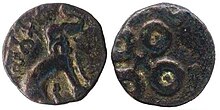Satakarni
| Satakarni | |
|---|---|
 Early coin of Satakarni, Maharashtra - Vidarbha type | |
| Satavahana King | |
| Reign | 1st century BCE |
| Predecessor | Kanha |
| Successor | Vedasri Satisiri |
| Spouse | Nayanika (Naganika) |
| Issue | Vedistri Satisisri |
| Dynasty | Satavahana |
| Father | Simuka |
| Satavahana kings 100 BCE–2nd c. CE | ||||||||||||||||||||||
|---|---|---|---|---|---|---|---|---|---|---|---|---|---|---|---|---|---|---|---|---|---|---|
|
||||||||||||||||||||||
Satakarni (Sātakarnī I) was the third of the Satavahana kings, who ruled the Deccan region of India. His reign dated variously as 70-60 BCE,[1] or 187-177 BCE.[2]
Biography
According to the Puranas, the Satavahana king Simuka was succeeded by his brother Krishna (also known as Kanha). According to Matsya Purana, Krishna was succeeded by Mallakarni, but according to other Puranas, he was succeeded by Satakarni. The Nanaghat cave inscription of Satakarni lists his family members: it mentions Simuka's name, but not that of Krishna. Based on this, multiple historians conclude that Satakarni was Simuka's son, and succeeded Krishna. G. V. Rao, however, believes that the inscription is that of a different king Satakarni II; Simuka is mentioned in the inscription as the founder of the dynasty.[3][4]
According to the Matsya Purana, Satakarni enjoyed a long reign of about 56 years.[5] He seems to have conquered Western Malwa[5] region from the Shungas.[citation needed]
He married Nayanika (Naganika), daughter of the Maharathi Tranakayiro Kalalaya, scion of the Amgiya (Ambhiya) family.[4] She wrote the Naneghat inscription, in which she describes Satakarni as "Lord of Dakshinapatha, wielder of the unchecked wheel of Sovereignty".[5] The Naneghat inscription of Naganika suggests that Satakarni performed two horse sacrifices (Aswamedha), to proclaim his sovereignty.[6]
Encounter with Kharavela
The Hathigumpha inscription of the Kalinga king Kharavela mentions a king named "Satakani" or "Satakamini", who is identified with Satakarni. The inscription describes dispatching of an army and Kharavela's threat to a city variously interpreted as "Masika" (Masikanagara), "Musika" (Musikanagara) or "Asika" (Asikanagara). NK Sahu identifies Asika as the capital of Assaka janapada.[7]: 127 According to Ajay Mitra Shastri, Asika-nagara was located in the present-day Adam village in the Nagpur district, where a seal mentioning the Assaka has been found.[8][9] The inscription also mentions a river, variously identified with Krishna or with the combined flow of Kanha-Wainganga.[10]
Since the inscription is only partially legible, different scholars interpret the events described in the inscription differently.
- According to K.P. Jayaswal and R. D. Banerji, Kharavela sent an army against Satkarani. Sailendra Nath Sen also states that Kharavela sent out an army that advanced up to river Krishna, and threatened the Musika city located near the junction of Krishna and Musi rivers (near present-day Nalgonda).[11]
- According to Bhagwal Lal, Satakarni wanted to avoid an invasion of his kingdom by Kharavela. So, he sent horses, elephants, chariots and men to Kharavela as a tribute. In the same year, Kharavela captured the city of Masika with assistance of Kusumba Kshatriyas.[12]
- According to Sudhakar Chattopadhyaya, Kharavela's army failed to advanced against Satakarni, and then diverted its course to threaten the city of Asika (Asikanagara).[6]
- According to Alain Daniélou, Kharavela was friendly with Satakarni, and only crossed his kingdom without any clashes.[13]
Succession
He was succeeded by his two young sons Vedasri (Khandasiri or Skandasri) and Sakti-Sri (Sati Sirimata) or Haku-Siri, under the regency of their mother Nayanika.[4]
Notes
- ^ Carla M. Sinopoli (2001). "On the edge of empire: form and substance in the Satavahana dynasty". In Susan E. Alcock (ed.). Empires: Perspectives from Archaeology and History. Cambridge University Press. p. 166-168.
- ^ Rajesh Kumar Singh (2013). Ajanta Paintings: 86 Panels of Jatakas and Other Themes. Hari Sena. pp. 15–16. ISBN 9788192510750.
- ^ Sudhakar Chattopadhyaya (1974). Some Early Dynasties of South India. Motilal Banarsidass. pp. 17–56.
- ^ a b c Raychaudhuri 2006, p. 346.
- ^ a b c Singh 2008, p. 382.
- ^ a b Sudhakar Chattopadhyaya (1974). Some Early Dynasties of South India. Motilal Banarsidass Publ. pp. 41–45. ISBN 978-81-208-2941-1.
- ^ N. K. Sahu; Kharavela (King of Kalinga) (1984). Khâravela. Orissa State Museum.
- ^ Ajay Mitra Shastri (1998). The Sātavāhanas and the Western Kshatrapas: a historical framework. Dattsons. p. 56. ISBN 978-81-7192-031-0.
- ^ Inguva Karthikeya Sarma; J. Vara Prasada Rao (1 January 1993). Early Brāhmī Inscriptions from Sannati. Harman Publishing House. p. 68. ISBN 978-81-85151-68-7.
- ^ Hasmukhlal Dhirajlal Sankalia; Bhaskar Chatterjee; Rabin Dev Choudhury (1989). History and archaeology: Prof. H.D. Sankalia felicitation volume. Ramanand Vidya Bhawan. p. 332.
{{cite book}}: Unknown parameter|coauthors=ignored (|author=suggested) (help) - ^ Sailendra Nath Sen (1999). Ancient Indian History and Civilization. New Age International. pp. 176–177. ISBN 978-81-224-1198-0.
- ^ Bhagwanlal Indraji (1885). "The Hâtigumphâ and three other inscriptions in the Udayagiri caves near Cuttack". Proceedings of the Leyden International Oriental Congress for 1883. pp. 144–180.
- ^ Alain Daniélou (11 February 2003). A Brief History of India. Inner Traditions / Bear & Co. pp. 139–141. ISBN 978-1-59477-794-3.
References
- Singh, Upinder (2008), A history of ancient and early medieval India : from the Stone Age to the 12th century, New Delhi: Pearson Longman, ISBN 978-81-317-1120-0
- Raychaudhuri, Hemchandra (2006), Political History Of Ancient India
- Sharma, Ram Sharan (1991), Aspects of Political Ideas and Institutions in Ancient India


